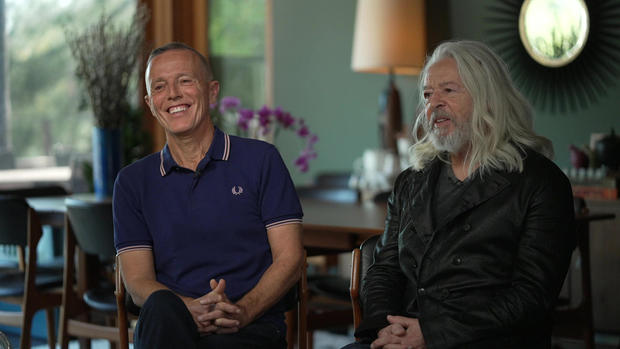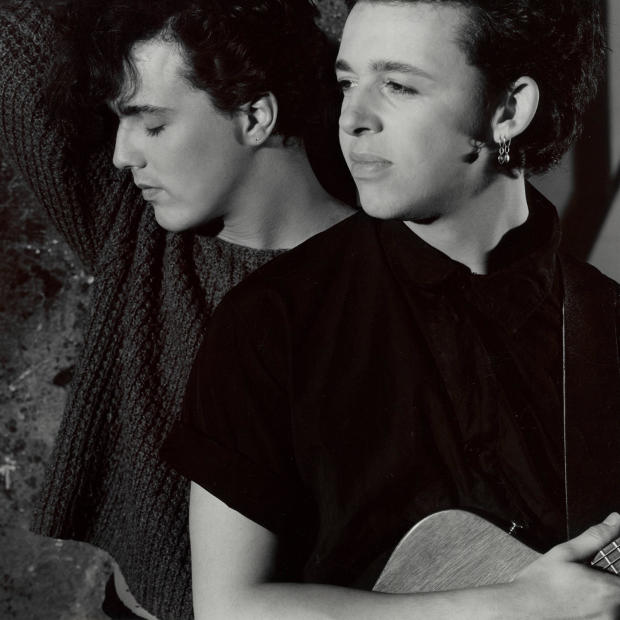▶ Watch Video: The return of Tears for Fears
Feel free to sing along:
Welcome to your life
There’s no turning back
Even while we sleep
We will find you
Acting on your best behavior
Turn your back on Mother Nature
Everybody wants to rule the world
In 1985, this song, “Everybody Wants to Rule the World,” was a Top-10 hit for the British pop group Tears for Fears, and it was only the first of many. On MTV and on the radio, their music was inescapable. And now, 40 years and 30 million albums later, it’s unforgettable.
These days, lead singer Curt Smith has a bit less hair; Roland Orzabal, the group’s co-founder, actually has a lot more. Both are 60 years old. And their signature sound is as flawless as ever.
Correspondent Tracy Smith met them at Curt Smith’s home in Los Angeles during a rare break in rehearsal. “So, how are you?” Tracy asked.
“Well, pretty good, thank you very much,” Curt replied.
“I’m very good,” said Roland. “Yeah. I’ve never felt better.”
“Is that true?”
“No,” he laughed.

They can laugh together now, but the fact that they’re even speaking is kind of a miracle.
In 1981, Orzabal and Smith were just two talented kids from Bath, England, who shared a love for music and a mild obsession with pop psychology. Orzabal said, “Our driving force was a theory by a Californian psychologist called Arthur Janov, who became famous, well-known because of his primal scream theory. And so, we bought into this big-time because we could, like, really blame our parents!”
And you could almost hear the angst in their music. Their first album, 1983’s “The Hurting,” was dark, brooding, and insanely popular.
“Change,” from “The Hurting”:
Their next album, “Songs From the Big Chair,” was even, well, bigger:
Shout, shout, let it all out
These are the things I can do without
Come on, I’m talking to you, come on
“Shout,” from “Songs From the Big Chair”:
On their first U.S. tour in 1985, the boys were mobbed at every stop. “It was a bit crazy because you couldn’t really go anywhere,” said Curt.
Because of the fans? “Well, you couldn’t really leave the hotel.”
Tracy asked, “What were the fans like?”
“Young!” said Roland.

“We were young then,” Curt said. “I mean, for me, the idea that someone could scream at you and, like, be crying when they don’t actually know you was peculiar. I always found that hard to deal with. You know, you kind of wanna go, ‘Really, I’m not what you think I am.'”
But they were rock stars, and with success came conflict. In the years that followed, Smith and Orzabal’s relationship fell apart, and in 1991 Smith left the group in what was a very bitter breakup.
Tracy asked, “You eventually made the split?”
“Yeah, I mean it was something we were both feeling,” Curt replied. “I just made the decision that, you know, I wanted to go and I wanted to move to New York. And it was, in retrospect, it is that trying to find yourself. I didn’t want to be that guy from Tears for Fears.”
Both kept making music, and kept their distance from each other.
“So, how long did the two of you go without speaking?” Tracy asked.
“Nine years,” said Roland. “Nine years, two months and three days.”
“… Four hours, six minutes, twenty-four seconds,” Curt added.
The ice finally broke in 2000, when they started speaking, and then, playing together, as in this performance at the 2017 Rock in Rio festival, in Rio de Janeiro:
But they say they didn’t really find their groove until they started writing together. Their new album, “The Tipping Point,” is their first in 17 years.
Tracy asked, “Is it fair to say that this album is getting back to just the two of you?
“Yeah, it feels that way,” said Curt. “We sat down, literally here, right here, with two acoustic guitars, and started writing. We hadn’t written together with just acoustic guitars, sitting, just the two of us, since we were probably 18 or 19.”
“Since you were teenagers, you hadn’t done it? What’d it feel like?”
“It felt necessary,” said Roland. “Absolutely essential.”
And now they’re making music that feels just as personal as it did in the old days.
The title track, “The Tipping Point,” was inspired by Orzabal’s late wife, Caroline, who died in 2017 after a long battle with alcoholism.
Life is cruel, life is tough
Life is crazy, then it all turns to dust
We let ’em out, we let ’em in
We’ll let ’em know when it’s the tipping point,
“We’d been drinkers, wine drinkers,” said Roland. “And, like, in England it’s kind of accepted as being okay. I’m drinking a bottle-and-a-half of wine a night, you know, that’s just me. Now, Caroline was matching me. And she was quite a small woman. So, her problem was largely due to alcohol.”
Orzabal wrote of his wife as a ghost of her former self:
So who’s that ghost knocking at my door?
(You know that I can’t love you more)
What’s that shape climbing over my wall?
(You know that I can’t love you more)
For Orzabal, the process of making the album was often difficult; doing it with an old friend made it bearable.
Tracy asked, “Roland, for you, did it change the way you looked at your relationship with Curt?”
“Yeah. Absolutely – I’ll try not to tear up now! – we went from butting heads to actually enjoying each other’s company. And most importantly, understanding each other’s strengths.”
Seems they’re stronger than ever now. Tears for Fears will be out on tour again soon, sounding pretty much the way you remember them.
Tracy asked, “Do you two need each other?”
“To do this, especially at this time in my life, definitely need him,” said Roland.
“Yeah, especially at this age,” Curt added. “As Roland says, it’s like, yeah, the more help you can get the – ”
“Help him up the stairs. That’s what he likes!” Roland laughed.
“The Tipping Point” by Tears for Fears (Concord Records) will be released February 25. To watch a music video for the album’s title track, click on the player below:
For more info:
- tearsforfears.com
- U.S. tour info (Beginning May 20)
Story produced by John D’Amelio. Editor: Mike Levine.







